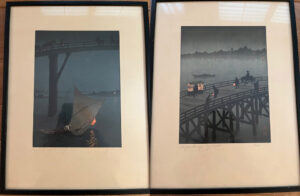 RF owns two exquisite Japanese woodcuts. She couldn’t make out the signature, but I did. Hiroshi Yoshida (1876-1950) became a leading artist of the Shin-hanga “new print” movement of the early 20th century in Japan. This movement focused on the techniques of traditional woodcut or watercolor, but borrowing from the Western style of landscape painting. The traditional Japanese woodblock process called “ukiyo-e” first developed in the 15th century. It portrayed landscapes and images of the theaters and brothels of the great cities. The name means images of “the floating world.” Yoshida’s art fused Eastern and Western traditions and became internationally successful.
RF owns two exquisite Japanese woodcuts. She couldn’t make out the signature, but I did. Hiroshi Yoshida (1876-1950) became a leading artist of the Shin-hanga “new print” movement of the early 20th century in Japan. This movement focused on the techniques of traditional woodcut or watercolor, but borrowing from the Western style of landscape painting. The traditional Japanese woodblock process called “ukiyo-e” first developed in the 15th century. It portrayed landscapes and images of the theaters and brothels of the great cities. The name means images of “the floating world.” Yoshida’s art fused Eastern and Western traditions and became internationally successful.
Yoshida ‘lived’ what he sketched
He travelled around the world four times on extended trips, producing remarkable woodblock prints of the Grand Canyon, the Swiss Alps, the Taj Mahal, and famous US National Parks. Six month tours with the rest of the year spent refining his sketches, he carved images into woodblocks for printing later. He became famous for his portrayal of mountains and images at night, described as luminous because he included a light source within the image that seemed to glow.
RF’s two woodcuts are nocturns. Both have lanterns a-glow as part of the narrative tale of the image. First, a fishing skiff under a high bridge with the water illuminated by an orange lantern behind the sail as the fisherman gazes. The other shows foot and horse traffic on the high bridge at night, the pedestrians carrying lanterns.
A technical reason makes these woodblocks glow. Hiroshi “struck” each paper print between thirty and a hundred times with the same woodblock, using different colors with each “strike.” The layering of colors meant the same image created by the same block printed out in different color combinations. He used the most advanced technique, called Betsuzuri, of the layering of colors to portray different times of day or different seasons of the SAME image. For example, in the series “Seto Inland Sea” Hiroshi portrayed two sailing ships at dawn, morning, midday, afternoon, evening, night, and in mist. The scene depicts the same boats over time.
Hiroshi’s staff of traditional carvers created the woodblocks “after” sketches by Hiroshi. He supervised throughout the carving and printing process. RF’s images contain the Japanese calligraphy “juzuri” stamp, which means “I the artist did this myself.”
Hiroshi formed Meiji Art Society
Hiroshi’s art teacher, a member of a multigenerational artistic family the Yoshidas, “discovered” him at the age of fifteen. They adopted him into this family. His adopted father, the artist Kasaburo and his artist wife Rui encouraged Hiroshi to learn from artists who painted in the Western (European) tradition. Hiroshi, as a student, formed the Meiji Art Society which merged Japanese tradition with Western traditions. It used brushstrokes of oil painting with the color expressiveness of watercolor, with the technical woodblock traditions of Ukiyo-e.
He lived that same international style in his career, bringing his watercolor paintings to the Detroit Museum of Art in 1899, the Museum of Fine Arts Boston 1900, The Paris Exposition in 1900, and the St Louis World’s Fair in 1904. He struck his first woodblock print in 1920, and established a studio in Boston in 1923 where he exhibited and sold. Soon his woodblocks became exhibited nationally in the US and Europe. In 1926, his most prolific year, he made forty-one woodblocks. With his artist son Toshi, he travelled to India and Southeast Asia to sketch in1930-31. A notable image was created of the Taj Mahal in the daylight and in the moonlight.
All in the Family
The Yoshida family, over four generations, and continuing to this day, spawned four male and four female notable artists, all with the name of Yoshida. This lineage progression is a tradition in Japanese woodcut art, which makes it difficult to date a work of art.
Hiroshi’s son Toshi, an artist born in 1911 and his brother Hadaka, also an artist, capitalized on the previously printed woodblocks their father passed to them in 1950. They reprinted them posthumously. These weren’t printed for the early 20th century Japanese market. The titles are written in pencil in English, the signature also Western style. This is the era of woodblock prints by Yoshida owned by RF. The size is the same as the original vintage print. I wager the Oban Tate-e size of ten by fifteen image size. Comparable sales of such images sold at auction at $900- $1,150 each.